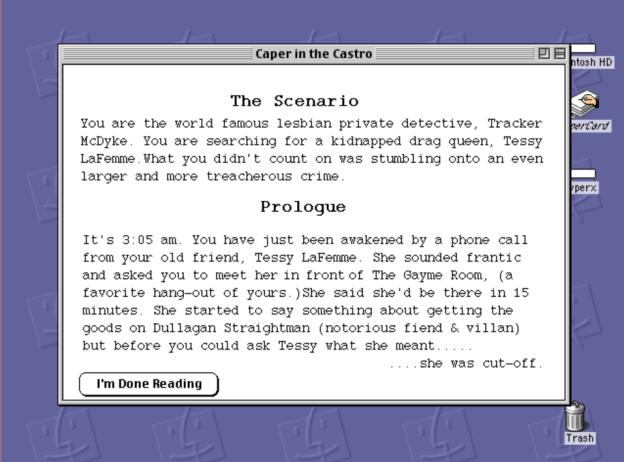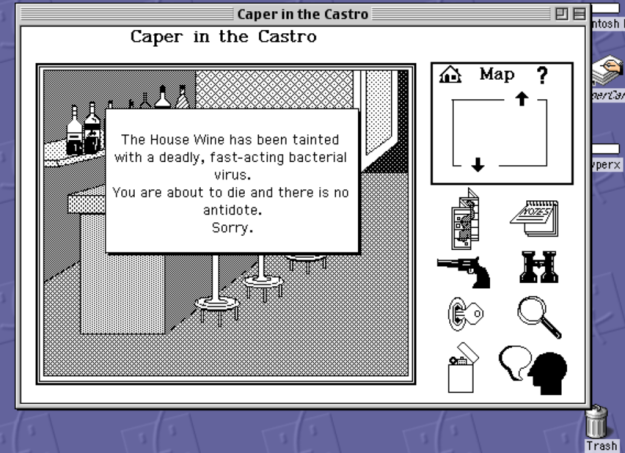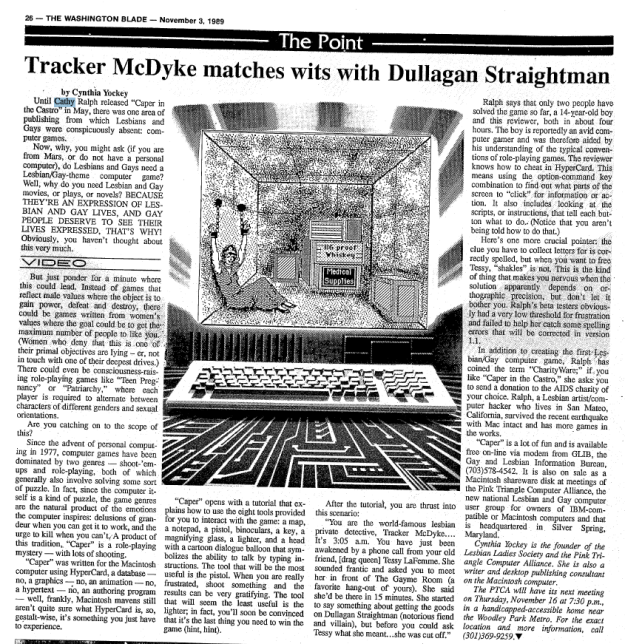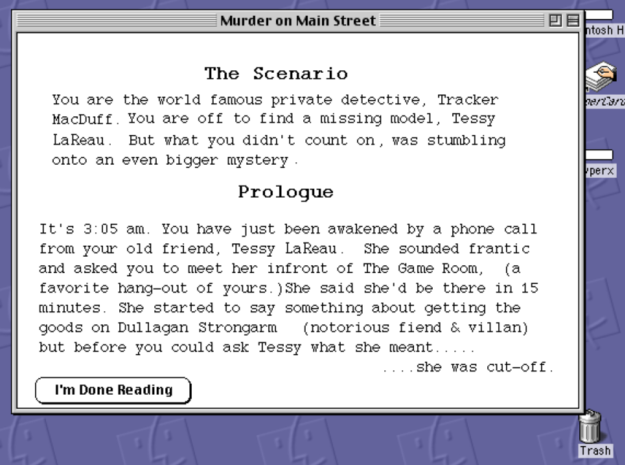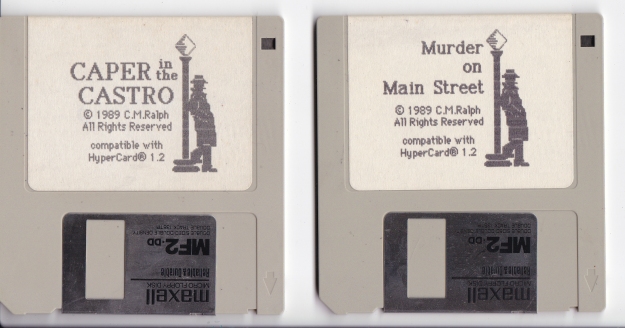A note from CM, January 2023 – I regret the spelling errors found in the game. I am mildly dyslexic and suck at spelling. Back in 1988, I had no one to edit my writing.I also regret some of the more “cringe-worthy” humor that is inappropriate by today’s standards.In some older video reviews as well as interviews, people have used the pronouns “she and her” when describing me.I am transgender and my preferred pronouns are “They, Them, and Their.”
COPYRIGHT NOTICE: Images from the game are used here with permission from the artist. Should you wish to use images from the, you must obtain permission from C.M. Ralph. Copyright and Licensing information for this game are available here: https://www.cmralph.com/caper-in-the-castro-legal-info
Year: 1989
Designer: C.M. Ralph
Country: USA
Platform: Mac
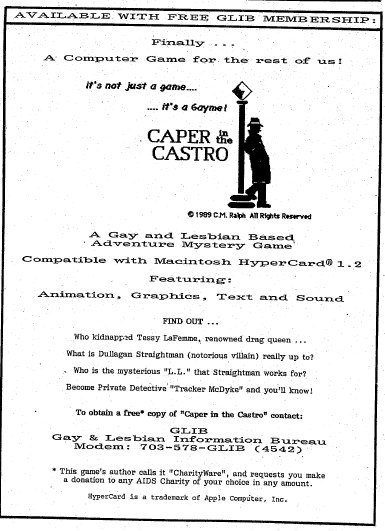
Advertisment for the game appearing the the Washington Blade in the June 30th issue
Caper in the Castro is a murder mystery/puzzle solving game, developed by C.M. Ralph in 1989. Based on all available information to date, it is the first gay and lesbian themed computer game.
In Caper in the Castro, players take on the role of a lesbian detective, Tracker McDyke, searching for their friend and drag queen, Tessy LaFemme, who has gone missing from the Castro. Earlier reporting on this game from 2014 mistakenly listed Tessy as a trans woman. Those were based on 2014 interviews with CM, who had not seen the game in decades and so didn’t clearly remember the details of the game. They have told us to go with the language from the game itself (below).
In the game, players can examine a series of spaces along Castro St. to try to find out what happened to Tessy, in the process learning that there might be other nefarious happenings going on. Moreover, as C.M. describes in an interview, “They had a lot of inside jokes. There was a lot of inside humor for the LGBT community at that time.”
The game was written in Hypercard which, according C.M., at the time was being sold as a business tool. They said “When I saw HyperCard’s capability, I thought you could tell a story with this. You could tell an interactive story with this.” And so they did! Over the course of a year, with a patient partner bringing then food and supporting them, they worked on the game: “I worked an eight hour a day job in Silicon Valley, and I would come home and lock myself in our studio room, bedroom, and work on this game just manically, and that went on for a year.”
It was originally released as “Charity Ware,” meaning anyone who downloaded it was asked to donate funds to an AIDS organization of their choosing. Having moved from Southern California to the Bay area, C.M. wanted to do something for the LGBT community that had embraced them and their partner while also honoring the nearly 90% of their Southern California friends who had died from AIDS related illnesses. Also (*spoiler alert*) there is one plot line of the game about releasing a bacterial virus type agent in drinks at the local bars referenced in the game.
As they put it: “I was coming from behind the orange curtain and the way were treated down there up to San Francisco and the way were treated in San Francisco. It was like two planets. I was so overcome with gratitude for the community that just embraced us, so I wanted to give something to the community. Sometimes creative projects are like that. They converge around a multitude of different things, and then that’s how this happened. The AIDS epidemic, my impulsive need to create things, and HyperCard’s abilities, everything. It all culminated.”
They and their friend Danny Nicoletta were invited to a symposium hosted by Pac Bell where they presented the game. They then explains how “Caper in the Castro” spread from the Bay Area all the way to Europe:
“After the little symposium, I got approached by this guy, and he says, you know, I run a bulletin board system, an underground bulletin board system in San Francisco and I would love to take your software and put it on there so that people can download it. I’m like sure. That was how it ended up on the first bulletin board, and from there it just literally organically went places. It went all the way across the United States, and then it hopped to Europe. Somebody took it over there and it got on their bulletin board systems, and then people over there were slopping it up. I would get phone calls, very strange phone calls, at odd hours from people, you know, are you CM Ralph? A lot of people just wanted to thank me for it, thank you for doing this and thank you for entertaining us… at one point we guessed that about 250,000 copies had been downloaded over a period of, I think, five years, but, I mean, we had no way of knowing. This was simply going by the bulletin board operators, their download statistics and stuff. I mean, we’ll really never know, but it went out there.”
The game was even covered by a reporter for the Washington Blade, Cynthia Yockey, who along with a 14-year-old boy was the only person to have solved it by November 1989. A copy of that article is available below.
In addition, Ralph made another version of the game called “Murder on Mainstreet” and sold it through Heizer Software. Knowing an LGBT related game might not be picked up by them, they “straightened up” the game.
“I took Caper in the Castro and I made a copy of it, and then I went through it card by card by card and made it straight… I straightened it [laughter], and I took out all the gay references. I took out all the references to the Castro, all the inside jokes, everything, and I renamed it Murder on Main Street. I sold it to Heizer Software, and I made, I mean, not a lot of money, but I made a steady income for many years from that program. It always cracked me up that these people were loving this game and buying it and had no idea it was actually an LGBT game [laughter].”
Having been able to recently play both versions of the game, the changes include a name change for the protagonist and Tessy being cast as a model rather than a drag queen (see below). Moreover the couples at the Red Herring Café swap partners in the “straightened” version. Also, some of the clues and answers change.
Moving this Summer CM found the original diskettes , and with the help of Andrew Borman and the Strong Museum of Play in Rochester New York, Ralph, and Adrienne Shaw were able to get the game in a playable format. Jason Scott at the Internet Archive then got it online, where you can play Caper in the Castro or Murder on Main Street. You can also watch a play through of the game here.
CM Ralph is now retired from a 42 year career in manufacturing and now works full time as a multimedia artist which you can learn more about and follow here. Also, they identify a non-binary transgender person and have never worked as game designer (something that has been misrepresented in various news stories about the game).
LGBTQ References in this game:
Citations:
- All interview quotes are from an interview with C.M. Ralph by Adrienne Shaw, September 27, 2017
- LGBT characters in video games (n.d.) Retrieved from https://en.wikipedia.org/wiki/LGBT_characters_in_video_games
- Puck Was Here. (2018, January 10). [Let’s Solve] Caper in the Castro [[Earth’s first Queer Videogame!!]]
- Winkie, L. (2014, April 18) From a pink dinosaur to “Gay Tony”: The evolution of LGBT video game characters. Salon. http://www.salon.com/2014/04/18/from_a_pink_dinosaur_to_gay_tony_the_evolution_of_lgbt_video_game_characters/
- Winkle, L. (2014, June 9). A Q&A with the designer of the first LGBT Computer Game. Paste. http://www.pastemagazine.com/articles/2014/06/caper-in-the-castro-interview.html
- Yockey, C. (1989, November 3). Tracker McDyke matches wits with Dullagan Straightman. The Washington Blade, p. 26.

